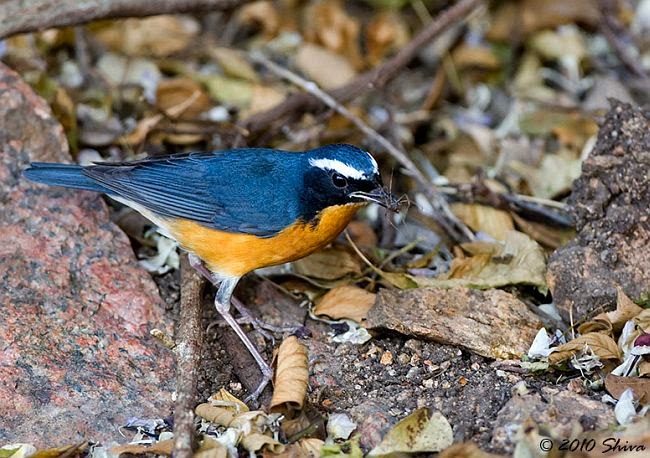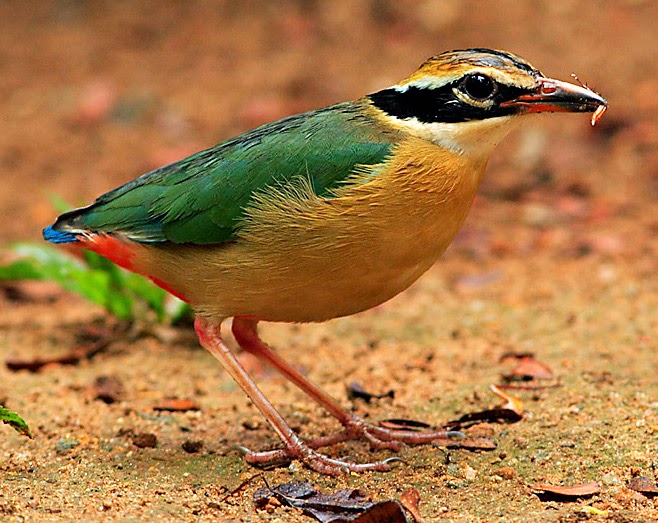A report (repeated below) appeared in a National newspaper this week about the sighting of Rosy Starlings in the Tiruvannamalai area.
“A flock of rosy starlings, a bird resembling a mynah but which has a distinct colour pattern, has been spotted in Tiruvannamalai. It is being claimed that it is the first time the bird is spotted here.
Painter and bird watcher Kumar alias Sivakumar spotted the bird in Samudram Eri during his regular bird watching a few days ago. “The birds with light pink pattern in its body came in large numbers like a cloud. They landed in the lake area. This is the first time I am observing them here,” he said.
 |
| Rosy Starlings on the Samudram Eri |
V. Arun, a bio diversity activist and expert, associated with Forest Way, an organisation that has been taking up successful afforestation project in the Tiruvannamalai hills, said that he has spotted rosy starlings in Mumbai and other northern part of the nation.
“They are migratory birds not frequently seen in South India. I have never seen them in Tiruvannamalai and never heard someone else spotting the bird here. Kumar’s spotting the bird is the first time probably,” he said.
“Ecology in Tiruvannamalai hill and surrounding areas is improving and we spot two-three new species every year here”. When asked how the bird was seen even after the winter is over, he said some migratory birds were seen for a few days in a spot while taking upward journey and they would be seen again for a few days in the same spot during their return journey. Kumar might have seen them on their return journey, he said.”
Below is information about the Rosy Starling, a new arrival to us at Tiruvannamalai.
 |
| Sturnus Roseus. Summer Plummage: Adult Male (Centre), Female (Below), Juvenile (Behind) |
The Rosy Starling (Pastor Roseus) is a Passerine Bird in the Starling family and is also known as the Rose-Coloured Starling or Rose-Coloured Pastor. In Tamil this bird is known as Cholam Kuruvi.
It is the size of a Mynah bird. Rose pink colour with glistening black head, neck and upper breast, wings and tail, and pale orange legs and bill. Males in the breeding season have a long, recumbent, pointed crest on the crown and nape which sometimes is more fluffed and prominent.
 |
| Duller and Browner Adults |
Females have a short crest and are duller overall, especially without the sharp separation between pink and black. Young birds and adults in winter plumage (non breeding) are duller and browner
 |
| Young Chick by Anura Chandak |
 |
| Rosy Starling Eating Grain |
Its keeps near cultivation, particularly Jowari (Sorghum) and ripening grain crops.
 |
| Starling at Indian Coral Tree |
This bird is attracted to flowering trees and nectar of Simal Flowers (Salmalia). It likes Banyan and Peepul figs, Lantana, Peeloo (Salvadora) and other berries. The Rosy Starling cross pollinates these types of trees.
Its diet is chiefly fruits, berries, flower-nectar, cereal grains and insects.
Males have a chattering, warbling song of harsh as well as pleasant notes uttered chiefly when satiated and resting in a shady tree during the mid-day heat. As well as its mixture of squeaks and rattles it also exhibits much wing trembling.
 |
| Rosy Starling Group on Tree by Mayank |
The Rosy Starling is a colonial breeder, and like other Starlings, is highly gregarious, forming large winter flocks. It breeds in Eastern Europe and Western and Central Asia on stony hillsides in May and June. The breeding grounds overlaps that of migratory locust and grasshoppers thus providing the staple food of this bird and its young from the time the latter hatch. In years when Grasshoppers and other insects are abundant, it will erupt well beyond its core range.
 |
| Rosy Starling Eating Insect by S. Gulavani |
It destroys locusts and grasshoppers on a large scale.
 |
| Distinct Colouration |
 |
| Rosy Starling by Anshul |
 |
| Group of Rosy Starlings |
 |
| Swarm of Starlings by Ashok Mashru |
The Rosy Starling is one of the earliest winter visitors. It begins arriving July-August and departs mid-April. It is often in small clouds of up to 500 birds or more. The bird can be found in winter throughout India. Its abundant in N.W. India and the Deccan and diminishes in number going southwards.


























